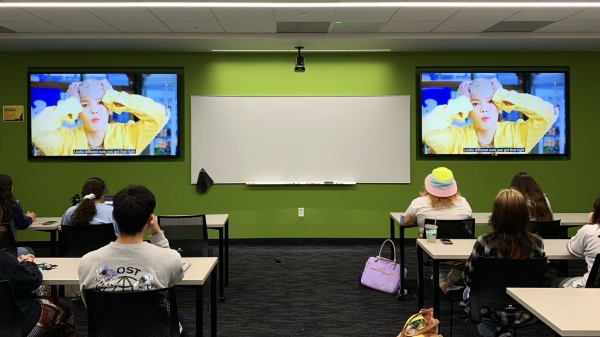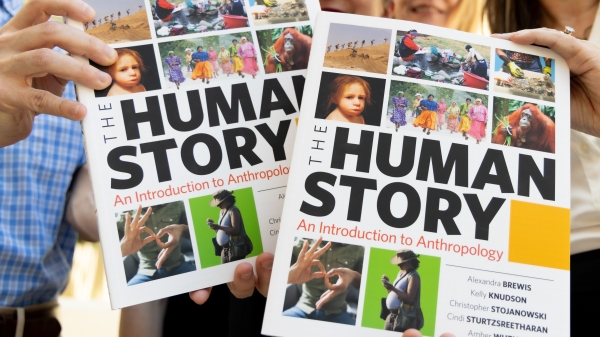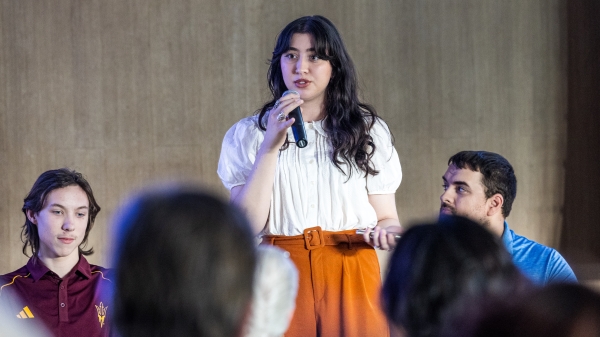ASU's Herberger Institute harnesses design and arts tools, content for community

Photo by Tim Trumble.
On March 24, Arizona State University’s annual Social Embeddedness Network Conference was hosted virtually for the first time, due to the COVID-19 pandemic.
In her opening remarks, keynote speaker and Herberger Institute Professor Maria Rosario Jackson said, “As we meet today, we must remember that this is a moment of crisis and hardship — and it is also a moment of possibility and transformation.”
This week, ASU’s National Accelerator for Cultural Innovation, a partnership between the Herberger Institute for Design and the Arts and ASU Gammage, launched Cultural Innovation Tools, a site that brings content and solutions together for the community to understand how arts and culture at ASU are responding to the moment.
In the face of the pandemic, students, faculty and staff at Herberger Institute are leveraging their creativity to pull together tools and resources for other artists/designers/culture makers, for families sheltering at home, for educators adapting their work online and for community organizations and government leaders who seek to partner with artists and designers as they respond and rebuild resilient and equitable communities.
“The National Accelerator advances how artists and designers can leverage their creative talent for transformation of just, equitable communities through new ways of practice and public policy,” said Jen Cole, director of the National Accelerator for Cultural Innovation. “No time is more urgent to imagine how artists and designers can lead change than in this moment, when our cultural sector is disrupted and artists themselves are struggling.”
Cole said that artists across the United States are leading social and policy adaptation in response to COVID-19 as well as leading change for social good, including prototyping new models of personal protective equpment with maker communities, radically rethinking music, dance and theater, and working in alignment with public health leaders to reimagine public communication for social distancing.
“We hope this site can be an entryway into this new way of thinking about how artists and designers are responding to the urgent needs of our country and our communities right now,” Cole said.
From podcasts exploring the effect of creative placemaking on Arizona communities, to a series of lively conversations with creatives conducted by Institute Professor Daniel Bernard Roumain, to online art talks and crafting activities hosted by the ASU Art Museum, Cultural Innovation Tools is designed to serve a wide range of people looking for more engagement with design and the arts.
The site features free resources, a toolkit originally created for area assisted-living leaders to coordinate educational programs virtually, and additional resources such as podcasts, concerts and videos, plus online modules from Institute Professors Liz Lerman and Michael Rohd and Evelyn Smith Professor Stephani Etheridge Woodson.
Lerman, a dancer, choreographer and MacArthur “genius grant” recipient, is interested in user feedback on the digital version of her “Atlas of Creative Tools” class, which she aims to grow into a “digital commons.” The Atlas of Creative Tools is a collection of artistic tools that Lerman has noted and gathered throughout her many years of practice, in addition to tools she's learned or come across through work with collaborators.
“I am hoping that this edition of the Atlas of Creative Tools aids those suddenly teaching online, either with its content or its structure,” she said. “There’s a special ‘perspectives’ section, which highlights the way the tools can be used by dancers of different genres, people of different ages, and folks from various disciplines.”
Rohd, a theater artist who works at the intersection of community change and creative work, said his course on expanding civic practice is aimed at supporting the capacity of anyone in arts/culture/design/heritage and municipal government, public health and community development in the work of cross-sector collaboration.
“I think at this moment, paying particular attention to equitable partnership practice and truly responsive recovery efforts is an urgent need,” Rohd said. “This course can really help in areas of project development, process design and relationship-building.”
In addition to launching the Cultural Innovation Tools, the National Accelerator for Cultural Innovation has partnered with the Arizona Commission on the Arts to provide local artists and cultural organizations with peer-to-peer support navigating stimulus resources to support employment and small business cohesion.
More Arts, humanities and education

New K-pop and Korean film classes launch at ASU
The Hallyu, or “Korean wave,” has made its way into Arizona State University classrooms with the arrival of a new professor who…

New book aims to change how anthropology is introduced to students around the world
With a combination of over a century of experience, five Arizona State University anthropologists wrote a new textbook that they…

Students host gun culture storytelling event with an intergenerational audience
According to Bobbie Reed — a resident of Arizona State University's senior living retirement community center, Mirabella — guns…